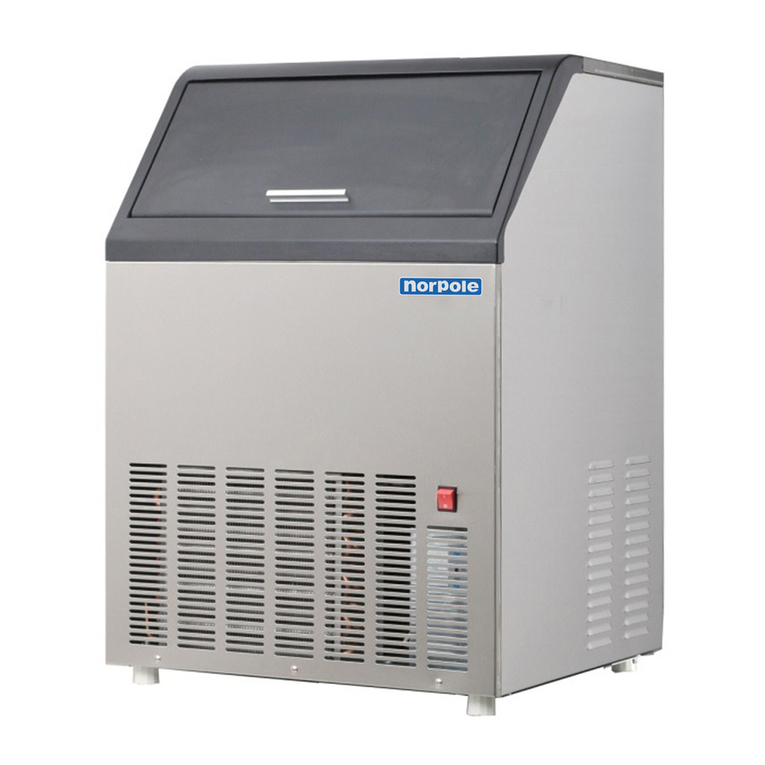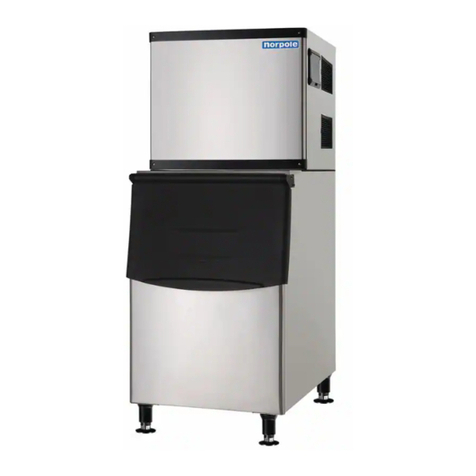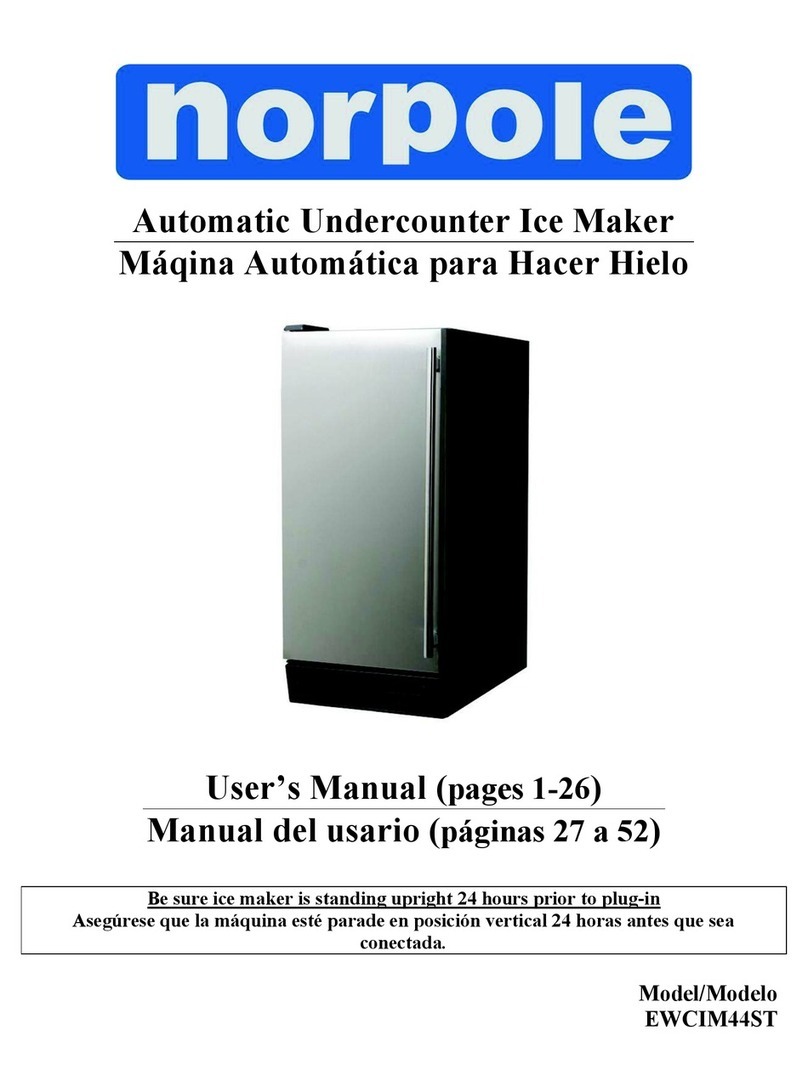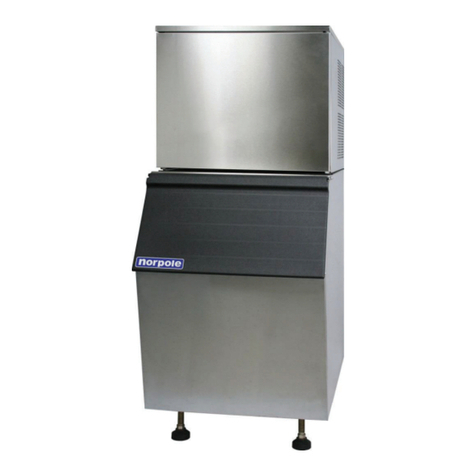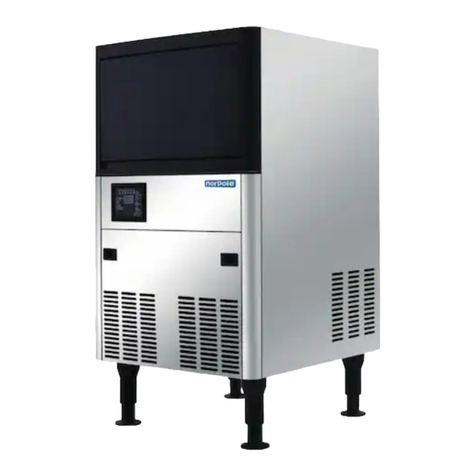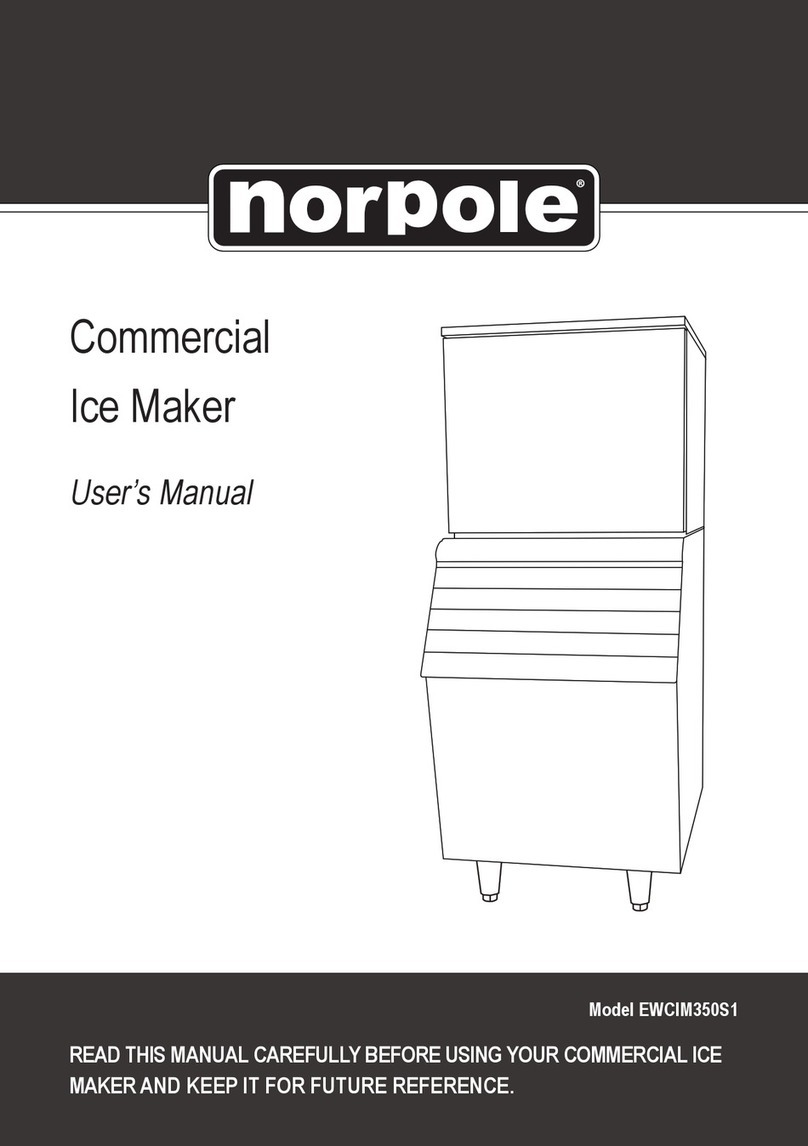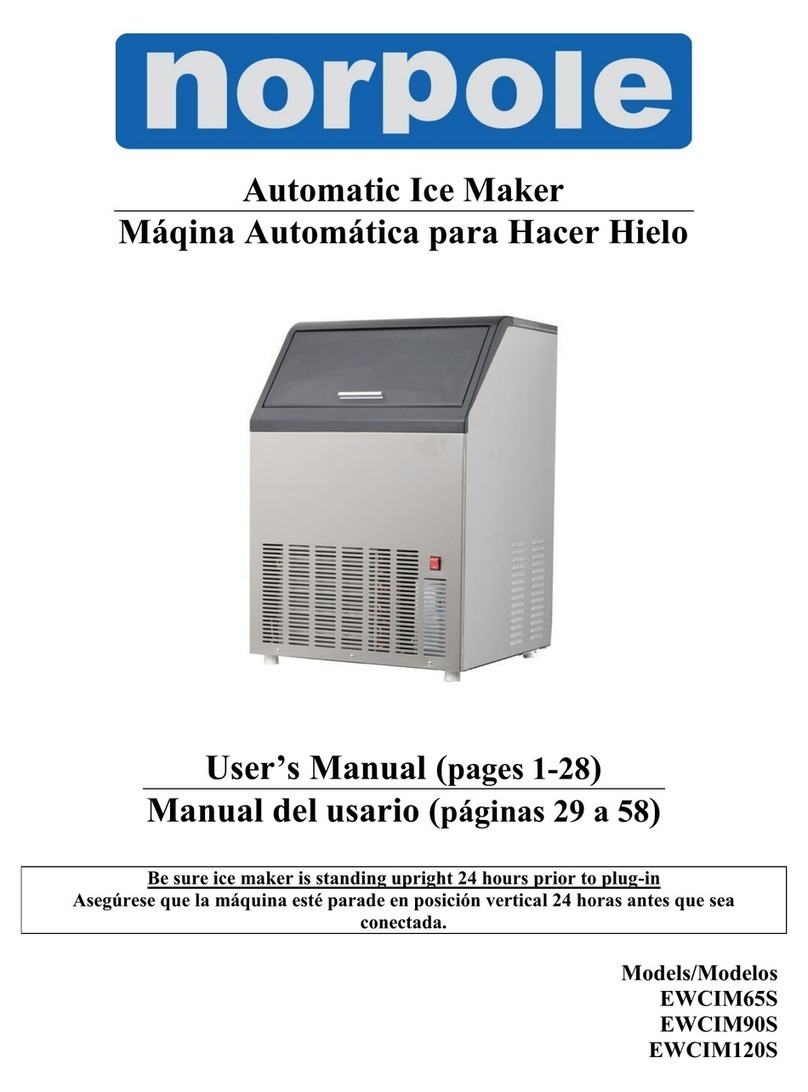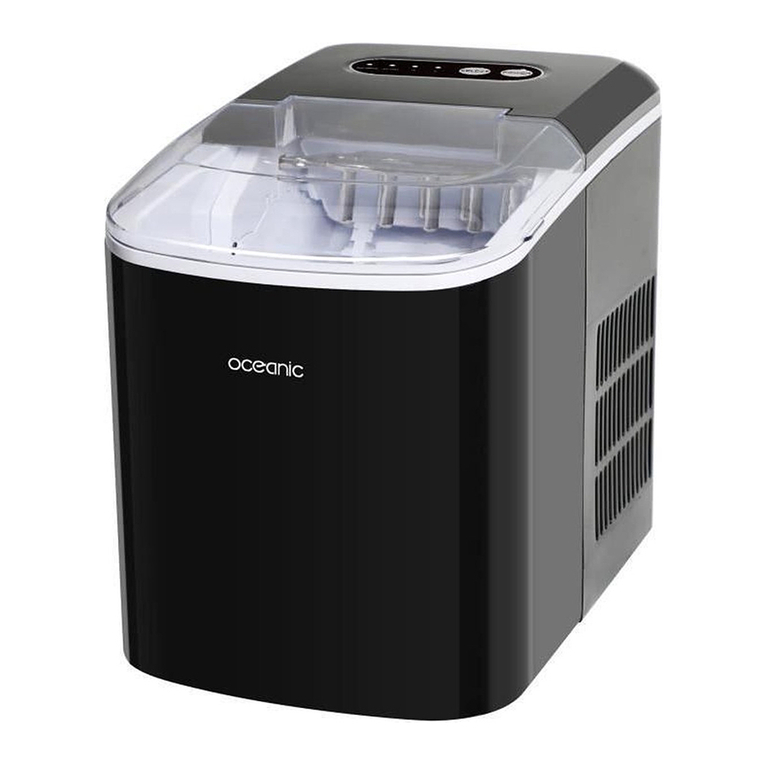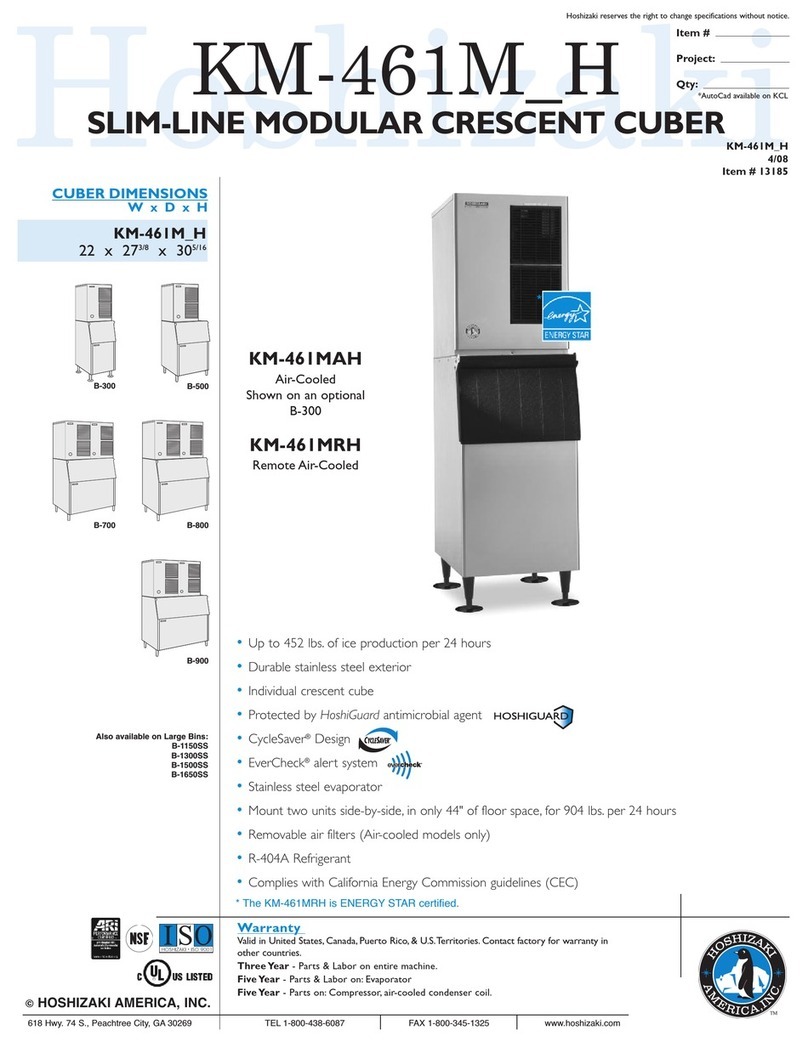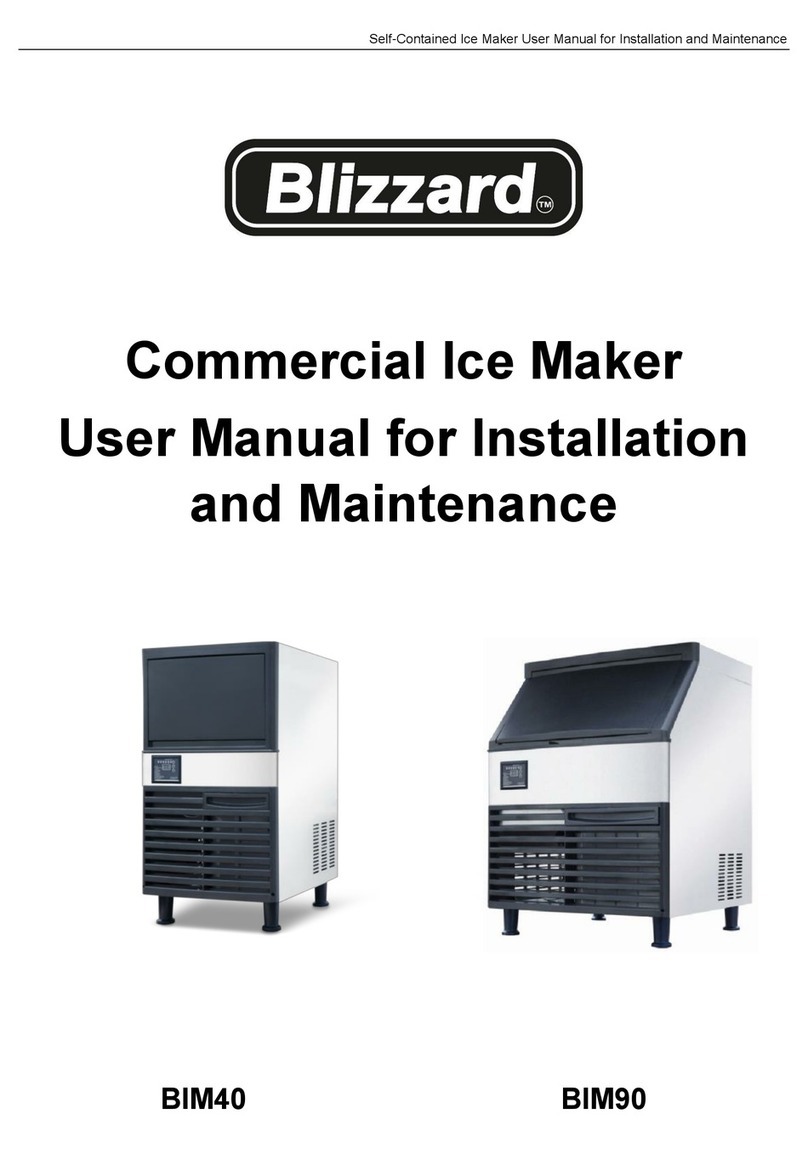NORPOLE EWCIM44ST User manual

Automatic Undercounter Ice Maker
//1 T- _
/ / if[
/,+
/f x"
f" _ /"
1
I I,,
i
I['!
c
, i
c
,, i /
,/
-/
'_ II /"
User's Manual
I Be sure ice maker is standing upright 24 hours prior to plug-in.
Model :EWCIM44ST

TABLE OF CONTENTS
Page
ICE MAKER SAFETY ..................................................................................................... 2
IMPORTANT SAFEGUARDS ................................................................................... 3 - 5
TECHNICAL INFORMATION ........................................................................................ 5
COMPONENT LOCATIONS ........................................................................................... 6
ICE MAKER INSTALLATION ................................................................................ 7 - 13
Unpacking ................................................................................................................ 7
Location requirements ....................................................................................... 7 - 9
Electrical requirements ............................................................................................ 9
Leveling the ice maker ........................................................................................... 10
Reversing the door swing ................................................................................. 10-11
Water supply .......................................................................................................... 12
Drain .............................................................................................................. !2 - 13
Installation types .................................................................................................... 13
OPERATION ............................................................................................................. 14-17
Final check List before operation ............................................................................ 14
Operating method .......................................................................................... 14 - 15
How the machine makes ice .................................................................................. t 5
How the machine uses the water ................................................................... 15 - 16
Normal sounds ....................................................................................................... 16
Preparing the ice maker for long storage ....................................................... 16 - t 7
CLEANING AND MAINTENANCE ..................................................................... 17 - 21
Exterior cleaning .................................................................................................... 18
Interior cleaning ..................................................................................................... 18
Condenser cleaning ................................................................................................ 18
Water distribution tube cleaning ............................................................................ 19
Ice-making system cleaning .......................................................................... !9 - 20
Control Panel ......................................................................................................... 21
MAJOR FUNCTION S .................................................................................................... 22
TROUBLESHOOTING .......................................................................................... 23 - 24
We reserve tile right to make changes in specifications and design without prior notice.

ICE MAKER SAFETY
Your safety and the safety of others are very important•
We have provided many important safety messages in this manual and on your appliance.
Always read and obey all safety messages.
This is the Safety Alert Symbol. This symbol alerts you to
potential hazards that can injure or kill you and others.
All safety messages will follow the Safety Alert Symbol and
either the words "DANGER", "WARNING" OR
"CAUTION".
DANGER means that failure to heed this
safety statement may result in severe
personal injury or death.
WARNING means that failure to heed this
safety statement may result in extensive
product damage, serious persona! injury or
death.
CAUTION means that failure to heed this
safety statement may result in minor or
moderate personal injury, or property or
equipment damage.
All safety' messages will alert you to what the potential hazard is, tell you how to reduce the
chance of injury, and let you know what can happen if the instructions are not fbllowed.
IMPORTANT SAFETY INSTRUCTIONS
WARNING: To reduce the risk of fire, electric shock or injuD" when using ),our ice
maker, tbllov,_s these basic precautions:
•Plug into grounded 3-prong outlet.
•Do not remove grounding prong.
• Do not use an adapter.
• Do not use an extension cord.
• Disconnect power before cleaning.
• Disconnect power before servicing.
•Replace all panels before operating.
• Use two or more people to move & install ice maker.
SAVE THESE INSTRUCTIONS

IMPORTANT SAFEGUARDS
Be/bre the ice maker is used, it must be properly positioned and installed as
described in this manual, so read the manual carefully. We strongly
recommends that you have a professional instatl your new machine. The
wan'anty may be affected or voided by an incorrect installation. To reduce the
risk of fire, electrical shock or injury when using the ice maker, Ibllow basic precautions,
including the following:
• Plug into a grounded 3-prong outlet; do not remove grounding prong, do not use an
adapter, and do not use an extension cord.
• It is recommended that a separate circuit, serving only for your ice maker, be provided.
Use receptacles that cannot be mined off by a switch or pull chain.
• Do not com_ect or disconnect the electric plug when your hands are wet.
• Never unplug the ice maker by pulling on the power cord .Always grip the plug fimaly
and pull straight out from the outlet.
• Never clean ice maker parts with flammable fluids. Do not store or use gasoline or other
flammable vapors and liquids in the vicinity of this or any other appliances. The fumes
can create a fire hazard or explosion.
• Before proceeding with cleaning and maintenance operations, make sure the power line
of the unit is disconnected and the water line is shut oft'.
*Before operating, pull all panels back into place.
• Never allow children to operate, play with or crawl inside the ice maker.
• Do not touch the evaporator with your hand when the machine is operating.
• Unplug the ice maker or discomaect power before cleaning or servicing. Failure to do
so can result in electrical shock or death.
• Do not attempt to repair or replace any part of your ice maker unless it is specifically
recommended in this manual. All other servicing should be referred to a qualified
technician.
• Use two or more people to move and instal! ice maker. Failure to do so can result in back
or other injury.
• To ensure proper ventilation for your ice maker, the front of the unit must be completely
unobstructed. Choose a well-ventilated area with temperatures above 50°F (10°C) and
below 100°F (38°C). This unit IVlUST be installed in an area protected fi'om the elements,
such as wind. rain, water spray or drips.
• _he ice maker should not be located next to ovens, grills or other sources of high heat.
•The ice maker must be installed with all electrical and water connections in accordance
with state and local codes. A standard electrical supply (115 V AC, 60 Hz. 15 A),
properly grounded in accordance with the National Electrical Code and local codes and
ordinances, is required.

• Do notkink orpinchthepowersupplycordbetweentheicemakerandcabinet.
• Thefuse(orcircuit breaker)sizeshouldbe15amperes.
• It isimportantfortheicemakerto beleveledin ordertoworkproperly.Othe_visewater
maynotflow properlytkroughtheevaporator(icemold).Theiceproductionwill beless
thannormal.Youmayneedtomakeseveraladjustmentstolevelit.
• All installationsmustbein accordancewith localplumbingcoderequirements.
• Makecertainthathosesarenotpinched,kinkedordanlagedduringinstallation.
• Checkfor leaksafterwaterlineisconnected.
• Althoughtheunithasbeentestedandcleanedatthefactory,dueto long-termtransitand
storage,thefirst batchof cubesmustbediscarded.
• Removethepackingmaterialsandcleantheicemakerbeforeusing.
• Turnonthewatersupplytap before switching on the ice maker. Never turn the water
supply tap off when the ice maker is working.
• Except to take ice from the unit, keep the door closed in order to reduce ice melting and
to promote proper ice formation.
• If the ice maker will not be used for a long time, before the next use it must be
thoroughly cleaned. Follow carefully any instructions provided tbr cleaning or use of
sanitizing solution. Do not leave any solution inside the ice maker after cleaning.
• Do not touch the condenser fins. They are sharp and can be easily damaged.
• DO NOT use solvent-based cleaning agents or abrasives on the interior. These cleaners
may transmit taste to the ice cubes, or damage or discolor the interior.
° The ice machine cleaner contains acids .Do not use or mix with any other solvent-based
cleaners products. Use rubber gloves to protect hands. Carefully read the safety
instructions on the container of the ice machine cleaner.
• Do not use the apparatus other than for its intended purpose,
SAVE THESE INSTRUCTIONS
Electrical Connection
Do not, under any circumstances, cut or remove the third (ground) prong from the power
cord. For personal safety, this appliance must be properly grounded. The power cord of
this appliance is equipped with a 3-prong grounding plug that mates with a standard
3-prong grounding wall outlet to minimize the possibility of electric shock hazard from
the appliance. Have the wall outlet and circuit checked by a qualified electrician to make
sure the outlet is properly grounded. When a standard 2-prong wall outlet is encountered,
it is your responsibility and obligation to have it replaced x.vith a properly grounded
3-prong walt outlet. The ice maker should always be plugged into its own individual
electrical outlet which has a voltage rating that matches the rating label on the appliance.
This provides the best performance and also prevents overloading house wiring circuits
which could cause a tire hazard from overheated wires. Never unplug your ice maker by
pulling on the power cord. Always grip the plug firl'My and pull straight out from the
outlet. Repair or replace immediately aI1 power cords that have become frayed or
otherwise damaged. Do not use a cord that shows cracks or abrasion damage along its
length or at either end. When moving the ice maker, be careful not to damage the power
cord.

Extension Cord
Because of potential safety hazards under certain conditions, it is strongly recommended
that you do not use an extension cord with this ice maker.
TECHNICAL INFORMATION
Model:
Electrical power:
Power consumption:
Ice-making/-harvest rated current:
Refrigerant:
High/Low side pressure:
Width x depth x height:
Unit weight:
Maximum ice storage:
Ice-making capacity:
Ice shape:
Ice cube dimensions:
AZ-20B
115VAC - 60Hz
13.2 kWh/100 lbs of ice
3.7A!4.8A
R134a, 7.06 oz.
350 psiJ130 psig
14%" x 235A'' x 33½"
84 lbs
25 lbs
44 Ibsiday*
cube
3/4" x 3/4" x 1"
Tile technical data and perfbrmance index listed above should be used for reference only.
They are subject to change.
"'The actual quantity of ice produced per day can vary with room and water conditions.

COMPONENT LOCATIONS
Door
Caster
!,i
P
1
/
/
r/
Water distribution tube
Evaporator (ice mold)
Water trough
Float
Ice storage bin
Control panel
Front louver panel
,:.Y C-
.- Power cord
,7
: ..Water inlet
_
L ....... Drain outlet
., _°4_
.-.-;yS
ice scoop
Water suppIy hose Drain hose

ICE MAKER INSTALLATION
Unpacking
Excessive Weight Hazard
Use two or more people to move and install ice maker.
Failure to do so can result in back oi other injury.
Remove packaging materials
IMPORTANT: Do not remove any permanent instruction labels or the data label on
your ice maker.
Remove tape and glue from )'our ice maker before using.
• To remove any remaining tape or glue, rub the area briskly with your thumb. Tape or
glue residue cm_ also be easily removed by rubbing a small amount of liquid dish soap
over the adhesive with your fingers. Wipe with warm water and dry.
• Do not use sharp instruments, rubbing alcohol, flalnlnable fluids, or abrasive cleaners
to remove tape or glue. These products can damage the surface of your ice maker.
Cleaning before use
After you remove all of the packaging materials, clean the inside of your ice maker before
using it. See the "Interior cleaning" in the Cleaning and Maintenance section.
Location requh'ements
IN5 TALLqTIO_ (LEAR.qA:( ES:
<
/-
TOP VIEW
/7 : , ." 1 ::
// /+ "./"
: : 2:"
/'!
:t
,4""
Rear of unit
"Side Side
E
Front of unit
/
/:
/.
/
:. ,':f
i"
,i ,_ /"
/
:I
i"
/ /
!
/.
/
/" 7/
j_
t: i
i
< 1
/•1
j"" !
t
/
SIDE VIEW
./ // / /:
• 2
/_,•," t
.... ;. .... X'.--'-'..
Top of unit
i
" --3 , .. ..... Tr-

• This ice maker should be properly installed by qualified personnel.
• To ensure proper ventilation for your ice maker, the front of the unit nmst be
completely unobstructed.
• When installing the ice maker under a counter° follow the recommended spacing
dimensions shown. Allow at least 4" (102 ram) clearance at rear, and I" (25 iron) at top
and sides for proper air circulation. The installation should allow the ice maker to be
pulled forward *br servicing if necessary.
• Choose a wel! ventilated area with temperatures above 50°F (10°C) and below 100°F
(38°C).This unit MUST be installed in an area protected from the elements, such as
wind, rain, water spray or drips.
• The unit should not be located next to ovens, grills or other high heat sources.
• installation of the ice maker requires a cold water supply inlet of ¼-in. (6.35mm) soft
copper tubing with a shut-off valve.
• The ice maker requires a cominuous water supply with a minimm-n pressure of 15 psig
and a static pressure not to exceed 80 psig. The temperature of the water feeding into
the ice maker should be between 41°F (5°C) and 90°F (32°C) lbr proper operation.
Normal operating ambient temperature should be between 50°F (10°C) to
100°F {38°C). Normal operating water temperature should be between 41°F
(5°C) and 90°F (32°C). Operation of the ice maker for extended periods out-
side of these normal temperature ranges may affect production capacity.
•It is strongly recommended that a waterf!/ter be ,tsed. A filter, if it is of the
proper type, can remove taste and odors as well as particles. Some water is very hard,
and softened water may result in white, mushy cubes that stick together. Deionized
water is not recommended.
• The ice maker nmst be installed with aI1 electrical and water connections in accordance
with all state and local codes.
• The unit should be located on a finn and level surface, it is important for the ice maker
to be leveled in order to work properly. If needed, you can adjust the height of the ice
maker by revolving the caster. See the Leveling the Ice at, ke,- section.
• A standard electrical supply (I15V AC only, 60Hz. 15A), properly grounded in

accordancewith the National Electrical Code and local codesand ordinances,is
required.
IMPORTANT:Do notkink orpinchthepowersupplycordbetweentheicemakerandwall
orcabinet.
Electrical requirements
Electrical Shock Hazard
Plug into a grounded 3- prong outlet.
Never remove the ground prong fi'om the plug.
Never use an adapter.
Never use an extension cord.
Failure to tk_llow these instructions can result in fire. electrical
shock or death
Before you move your ice maker into its final location, it is important to make sure you
have the proper electrical connection:
A standard electrical supply (115V AC only, 60Hz, 15A), properly grounded in accordance
with the National Electrical Code and local codes and ordinances, is required. The ice
maker should always be plugged into its own individual electrical outlet.
It is recommended that a separate circuit, serving only 3'our ice maker, be provided. Use a
receptacle that camaot be turned offby a switch or pull chain.
The Ihse (or circuit breaker) size should be 15 amperes.
Recommended grounding method
For ,,our personal safety, this appliance must be grounded. This appliance is equipped with
a power supply cord having a 3-prong grounding plug. To minimize possible shock hazard,
the cord must be plugged into a mating 3-pronged and grounding-type wall receptacle.
grounded in accordance with the National Electrical Code and local codes and ordinances.
If a mating wall receptacle is not available, it is the personal responsibility ol'the customer
to have a properly grounded. 3-prong wall receptacle installed by a qualified electrician.

Leveling the ice maker
tt is important for the ice maker to be leveled in order
to work properly. Otherwise water will not flow
properly through the evaporator (ice mold). The
ice production will be less than normal, and may
be noisy. The unit can be raised or lowered by rotating
the plastic sheaths around each of the four rolling
casters on the bottom of the machine. If you
find that the sur[hce is not leve!, rotate the casters
until the ice maker becomes level. You may need
to make several adjustments to level it. We
reconmaend using a carpenter's level to check
the machine.
// -L_ -L /
up
/down
/
1. Place a calpenter's level on top of the unit to see if the ice maker is level from fiont to
back and side to side.
2. Adjust the height of the casters as follows:
Turn the leveling casters to the right to lower that side of the ice maker.
Turn the leveling casters to the left to raise that side of the ice maker.
You will find that the casters make it easy for one person to move the machine. This is
useful for cleaning and sanitizing the surface on which the ice maker is installed because it
al!ows you to move the unit and have easy access to the surface to be cleaned.
IMPORZ4NT. Ilqwn the ice maker is' ready to be installed in a cabinet or direct@ on the
flora; 3'ou must adjust the feet to level the ice maker and lock the rollers. If the Jloor is
level, just revoh'e the twoji'ontjeet to touch the floot:
Reversing the door swhtg
Tools needed: flathead screwdriver: Phillips screwdriver
IMPORTANT: Before )'ou begin, unplug the ice maker or disconnect powel:
To remove door from hinges:
l. Remove the top hinge cover.
2. Using a Phillips screwdriver, remove the screws, then remove the top hinge mat and
top hinge. Keep the parts together and set them aside.
3. Lift the door offofthe bottom hinge and set the door aside.
To replace door on hinges:
l. Using a flathead screwdriver, remove the plug buttons from the screw holes opposite the
door hinges, top and bottom. Set aside.
2. Remove the fiont louver. Set aside.
3. Remove the bottom hinge and place it on the opposite side at the bottom of the door.
lo

4. Position the door on the bottom hinge.
5. Align the door on the bottom hinge and replace the top hinge and top hinge mat.
6. Replace top hinge cover.
7. Push the plug buttons into the original screw holes.
See Figure below.
cabinet Top hinge mat
Top hinge
v- _ r;
.'- Door
-2I
i
i • •
Bottom]tinge
_ - . :!
il " Top hinge
f_
I!
,i
i
i -
r i',
!:a x':-, --J
Bottomhinge.
/j"
f
I1

Water Supply
The water supply should be ready at the point of installation. The water supply pressure
should be a minimum of 15 psig with a static pressure not more than 80 psig. (A wall
outlet directly behind the ice machine wii! make installation easier.)
IMPORTANT:
1. All installations must be in accordance with local phtmbing code requirements.
Professional installation is recommended.
2. Make certain the hoses are not pinched or kinked or damaged d.ring installation.
3. Check for leaks after connection.
Tools required:
;4-in. open-end wrench, Phillips screwdriver
Connecting the water line:
I. Turn off main water supply. Turn on the nearest thucet long enough to clear line of
water.
2. Find a ½-in. to _i4-in. vertical cold water pipe near the installation location. The
distance should be less than 9 feet. the water supply hose provided with the ice maker
is about 9feet long.
3. A shut-off valve must be installed to the main water supply. If the water pipe has a
plain piece of copper tubing, attach a ¼" O.D. compression union to the tubing and
remove the nut.
4. Connect the nut of the water supply hose to the tap. and connect the other end with the
water inlet. Tighten firmly by hand, then one-half turn with wrench.
5. Turn on main water supply and tap. Check tbr water supply connection leaks. Tighten
every- connection (including connection at the water inlet).
IMPORZ4NT: When you compeer the water supply hose and the drain hose, pay attention
to the indicariom o/" ""Water inlet '" amt "'Drai_ outlet "' on the machine.
Drain
)bu must com_ect the drain line be/ore using the ice make1: (The Dual Drainage.ibature of
earlier models has been modified to simpli.i)" the ch'ainage procedure.) Follow the stel)s
outlined betou:
Connecting the drain line:
NOTE: If there is adrain line near the ice make_; the best choice to drain water to
the drain line through the drain water hose provided with ice maker.
I. Locate the floor drain near the ice maker. The distance should be less than 5 feet since
the length of the long drain water hose provided with the ice maker is about 5 feet.
Find the drain outlet on the back of ice maker. Connect the drain outlet to the water
draining hose, and insert the other end o1' the hose into the drain line.
NOTE: Never allow the drain hose to hang or loop higher than the .!toor of the ice
storage bin.
12

2. All horizontal runs of drain lines must have a fall of ¼" per foot. An air gap will likely
be required between the ice maker drain tube and the drain/waste receptacle, A
standpipe with a trap below it would be acceptable for the drain/waste receptacle. A
floor drain is also acceptable.
3. Pour 1 gallon of water into the ice storage bin to check for leaks in the drainage system.
Tighten any connections that leak.
IMPORTANT." This ice maker is not a freezer Infrequent drainage will
cause a high rate of melting in the ice storage bin.
Installation Types
This ice maker has been designed for Mobile (free-standing) installation. However° it can
also be Enclosed (as under a cabinet) or Built-in (sealed to the floor). In any case, there
must be adequate air space around the unit for ventilation.
Mobile installation:
A mobile installation will allow you to install the ice maker free-standing in any place you
desire provided you have access to a water supply. You nmst follow the stated instructions
for
a. Electrical requirements
b. Water supply
c. Leveling the ice maker.
Enclosed Installation:
An enclosed installation will allow you to install the ice maker under a cabinet, or in a
kitchen cabinet provided the required clearance space around the ice maker is respected.
This installation has the same requirements as a mobile installation.
Built-in installation:
If this method of installation is chosen, it will still be necessary to allow adequate
ventilation space around the unit. The tbllowing additional items must be observed.
I. Place ice maker in fi'ont of installation location. Remove the feet and place the unit flat
on the floor or on a platform depending on your installation requirements.
2. The water supply iine must be plumbed betbre connecting to the ice maker.
3. Turn on main water supply' and tap. Check lbr water supply connection Ieaks. Tighten
every connection (including connection at the water inlet).
4. If the eIectrical outlet for the ice maker is behind the cabinet, plug in the ice maker.
5. Push the ice maker into position.
6. Seal all around the cabinet to the floor with an approved caulking compound.
I:\IPOREqNT. Be sure the ch'ain hose is connected and.ied into the ch'uin line beJbre the
ice maker is moved into its finalposition.
13

OPERATION
Final Check List before Operation
1. Have all packing materials and tape been removed from the interior and exterior of the
ice maker?
2. Did you clean the ice storage bin?
3. Have the installation instructions been follov,,ed, including co_mecting the machine to
water and electricity?
4. Has the machine been leveled?
5. Is the ice maker in a site where the ambient temperature is between 50°F (10°F) and
100°F (38°F) and the water temperature between 4 t °F (5°F) and 90°F (32°F) all year-
round?
6. Has the water supply pressure been checked to ensure a minimum of t5 psig with a
static pressure not to exceed 80 psig?
7. Is there a clearance of at least 4" (102 ram) at the rear, and I" (25 into) at top and sides
for proper air circulation?
8. Has the power supply voltage been checked or tested against the namepIate rating?
And has proper grounding been installed in the ice maker?
9. Is the ice maker plugged in?
10. Have you turned on the main water supply and tap?
1 I. Have you checked for leaks at all water supply connections?
Operating method
I. Turn on the water tap, let the water trough fill then press the ON/OFF button on the front
panel. _fhe ice maker will stm_ working automatically.
Ice making stage Ice harvest stage Bin full stage
,_.'_After 3 minutes, the machine will automatically, go to the ice-makin_ sta_,e_= . and the
sot.rod of water flowing will be heard.
3. When the batch of ice has been fully tbrmed, ice wilt automatically be harvested to the
14

ice storage bin.
4. When the ice storage bin is full, the sheet of cubes will not fall completely and will
hold the bin-l\dl probe open. The machine automatically stops making ice and
progresses to the cold preservation stage. During this stage, the compressor works
regularly to keep the temperature low for less ice melting.
5. The unit will start making ice again after the ice cubes are removed. Then the bin-full
probe swings back to operating position.
IMPORZdNZ
•Although the unit has been tested a_Td cleaned at the factor3; due to long-term transit
and storage, the Jilwt batch of cubes must be discarded.
• Never turn the water supply mp offwhetl the ice maker is working.
• Never touch evaporator when unit is running!
•Except to rake ice ,[tvm the unit, keep the door closed to reduce melting and insure
proper ice formation.
How the machhte makes ice
Set the ON/OFF button to the ON position. The machine will automatically go to the ice
making stage.
There are two distinct cycles: ice fi'eeze and harvest.
The freeze cycle happens when water flows to the evaporator surface. The harvest cycle is
when the ice is released and water enters the machine. A complete cycle takes about 20
minutes, but it depends on temperature and operating conditions.
Freeze: During the fi'eeze cycle the compressor is pumping refi'igerant, the fan motor is
blowing air, and the water pump is circulating water. When the batch of ice has been fully
formed, the ice maker stops the fi-eeze cycle and harvest cycle begins.
Harvest: During the harvest cycle the compressor is still operating, but the water pump
has stopped. The hot gas valve opens, diverting hot refrigerant gas into the evaporator. The
hot refrigerant gas warms the evaporator, causing the cubes to slide as a unit off the
evaporator and into the s{orage bin. The tieeze cycle will restart when atI the cubes have
been harvested.
How the machh_e uses the water
The ice maker begins with a fixed charge of water that is contained in the water trough. As
the water flows to the freezing evaporator surface, the portion of water that does not
contain mineral impurities fi'eezes and sticks to the ice cube molds. The water containing
impurities falls back into the water trough. During the ice making process, fresh water
enters into the water trough continuously as the water in trough fi'eezes continuously in the
evaporator.
15

Water inlet Water pump
Hot gas valve____
_Fan motor _ it?]:
Condenser 1_
I,
l:' I
........ ,_ _ Cotm_ressor
I
Normal sounds
Your new ice maker may make sounds that are not t_amiliar to you. Most of the new
sounds are normal. Hard surl:aces like the floor and walls can make the sounds louder than
they actually are. The following list describes the sounds that might be new to you and
what may be causing them.
• Rattling noises may come from the flow of the refi'igerant or the water line. Items
stored on top of the ice maker can also make noises.
• The high efficiency compressor may make a pulsating or high-pitched sound.
• Dater rmming may make a splashing sound.
• You may hear air being forced over the condenser by the condenser fan.
• During the harvest cycle, you may hear the sound of ice cubes falling into the ice
storage bin.
Preparing the ice maker for long storage
If the ice maker will not be used ]?'ora long time. or is to be moved to another place, it will
be necessary to drain the system of water.
1. Shut offthe water supply at the main water source.
2. Discomaect the water supply line from the water inlet.
3. Shut offthe electric supply, at the main electrical power source.
4. Take out the ice storage bin to remove any remaining ice m_d water Dry the bin.
5. Pull off the drainage tube of the water trough to drain off all water.
I6

6. Leave the door open to allow for circulation and to prevent mold and mildew'.
7. Leave water supply line and power cord disco_mected until ready to reuse.
IMPORTANT."
•Do not touch the power plug when),our hands" are wet.
•Never unplug the unit bypulling on the cor'd. Grasp the plug andpull outfirml);
CLEANING AND MAINTENANCE
If tile ice maker is left unused [br a long time, befbre the next
use it must be thoroughly cleaned. Follow carefully any
instructions provided for cleaning or use of sanitizing
solutions. Do not leave any solution inside the ice maker after
cleaning.
Periodic cleaning and proper maintenance will ensure efficiency, top perlbrmance, and
long lit). The maintenance intervals listed are based on normal conditions. You lnay want
to shorten the intervals it"you have pets, or there are other special considerations.
What shouldn't be done
Never keep anything in the ice storage bin that is not ice: objects like wine and beer
bottles are not only unsanitary, but the labels may slip off and plug up the drain.
What parts should be kept clean
There are 5 things to keep clean:
1. The exterior
2. The interior
3. The condenser
4. Water distribution tube
5. 2Fhe ice-malting system
17

Before proceeding with cleaning and maintenance operations,
make sure the power line of the unit is disconnected and the
water line is shut off.
Exterior cleaning
The door and cabinet may be cleaned with a mild detergent and warn1 water solution such
as I oz. of dishwashing liquid mixed with 2 gallons of wama water. Do not use
solvent-based or abrasive cleaners. Use a soft sponge and rinse with clean water. Wipe
with a soft clean towel to prevent water spotting.
If the door panel is stainless steel, stainless steel can discolor when exposed to chlorine
gas and moisture. Clean stainless steel with a mild detergent m_d warm water solution and
a damp cloth. Never use an abrasive cleaning agent.
Interior cleaning
The ice storage bin should be sanitized occasionally. Clean the water trough betbre the ice
maker is used first time and reused after stopping for an extended period of time. It is
usually convenient to sanitize the trough after the ice making system has been cIem_ed.
and the ice storage bin is empty.
1. Disconnect the power to the unit.
2. Open the door and take out the removable ice storage bin. With a clean cloth, wipe
down the interior of unit and ice bin with a sanitizing solution made of 1 ounce of
household bleach or chlorine and 2gallons of hot (95°F - I15°F) water.
3. Rinse thoroughly with clear water.
4. Screw offthe drainage nut to drain completely.
5. Put the ice storage bin inside the unit.
6. Reconnect power to the unit.
The ice scoop should be washed regularly. Wash it just like any other Ibod container.
DO NOT use solvent-based cleaning agents or abrasives on the
interior. These cleaners may transmit taste to the ice cubes and
damage or discolor the interior.
I8

Comlenser cleaning
A dirty or clogged condenser prevents proper airflow, reduces ice making capacity, and
causes higher than recommended operating temperatures that may lead to component
failure. Have the condenser cleaned at least once every six months.
1. Unplug the ice maker or discmmect power.
2. Gently pull off the lower front louver.
3_ Remove dirt and lint from the condenser fins and the
unit compartment with the brush attachment of a
vacuum cleaner.
4. Reassemble the lower fi'ont louver.
5_ Plug in the ice maker or recolmect power.
J
, .L
' i
I
i!
I E
-. ,_;.g.>._
, II_-_ '_-,_ _
- Ib_':._,.¢<_Cq_:
DO NOT touch the condenser fins. They are sharp and can be easily damaged.
1
I
I
Water distribution tube cleaning
When you find the ice cubes are incompletely tbmaed or the output is lo_x5 the water
distribution tube may be blocked. Turn off the power button, rotate the water distribution
tube, locate the holes in the distribution tube and use a pointed object such as a toothpick
to dredge the holes. Then rotate the water distribution tube back to its original position. If
the tube is badly blocked, clean it as follows:
1. Shut otl'the water supply
2. Disconnect the water hose fi'om the distribution tube.
3. Lift the right side up, then remove the distribution tube.
4. With a brush, clean the tube with a dilute solution ofwann water and a mild detergent
such as dishwashing liquid. After removing the dirt and lint tiom the sm'face, rinse the
tube with clean water.
5. Replace the distribution tube.
6. Reconnect the water supply;.
Ice-mal,-htg system cleaning
Minerals that are removed fi'om the water during the freezing cycle will eventually *brm a
hard, scaly deposit in the water system. Cleaning the system regularly helps remove the
mineral scale buildup. How often to cIean the system depends upon how hard your x_ater
is or how effective your filtration may be. With hm'd water of 15 to 20 grains/gal. (4 to 5
grains/liter), you may need to clean the system as often as once every 6 months.
19
Other manuals for EWCIM44ST
1
Table of contents
Other NORPOLE Ice Maker manuals
Popular Ice Maker manuals by other brands
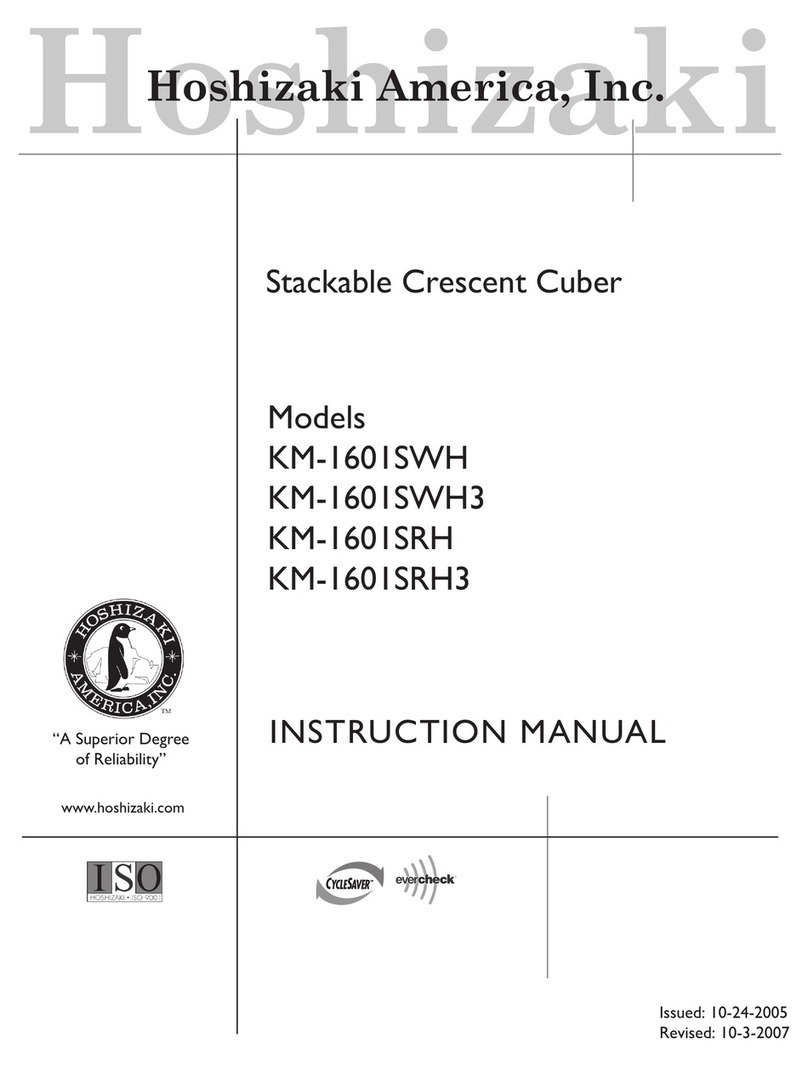
Hoshizaki
Hoshizaki KM-1601SRH instruction manual
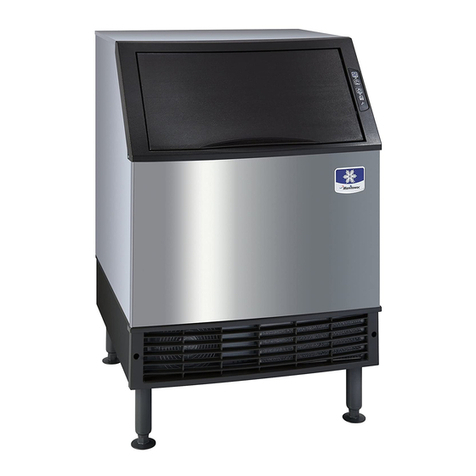
Manitowoc
Manitowoc STH042 7/15 Technician's handbook
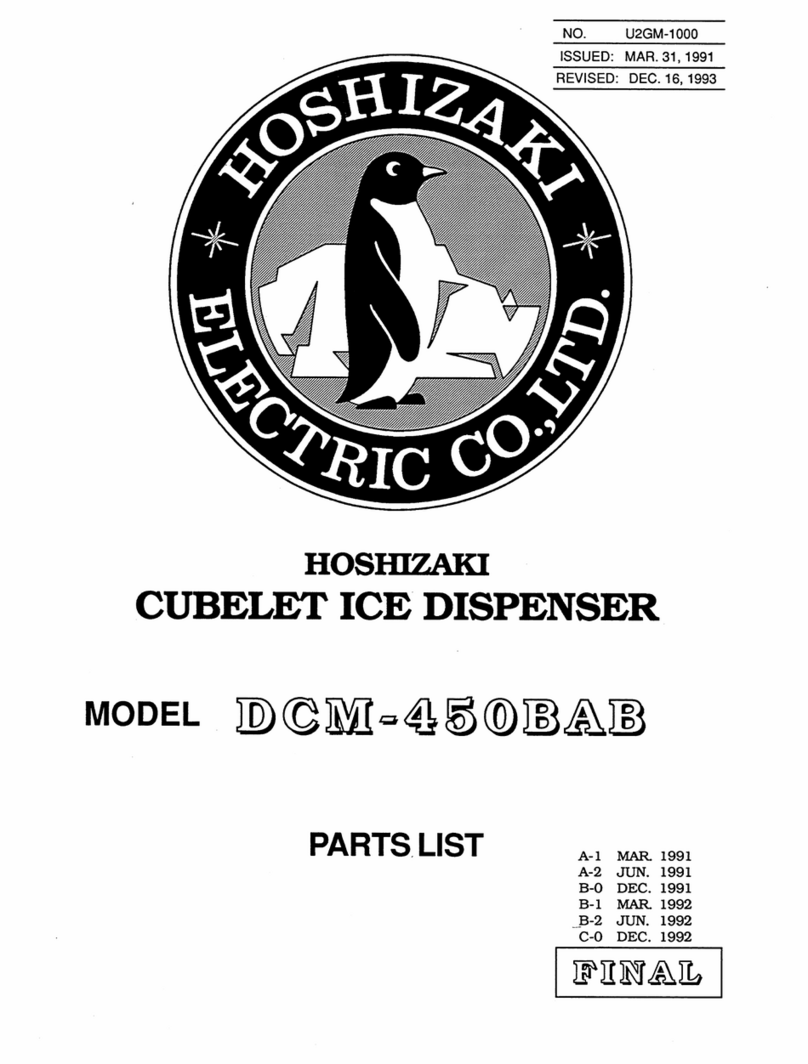
Hoshizaki
Hoshizaki DCM-450BAB parts list
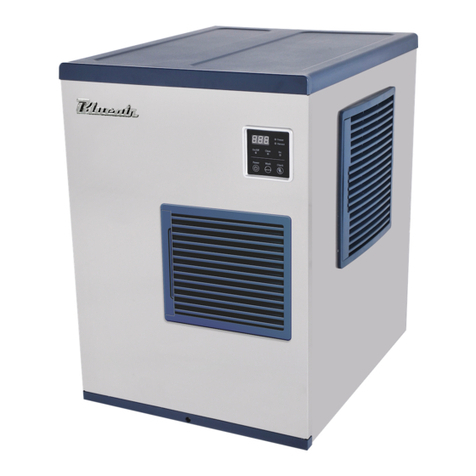
Blueair
Blueair BLMI-300A Service manual
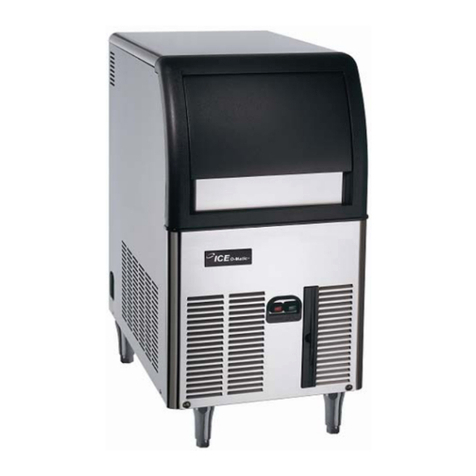
Ice-O-Matic
Ice-O-Matic Ice Undercounter Series Cubers ICEU070A Service & parts manual
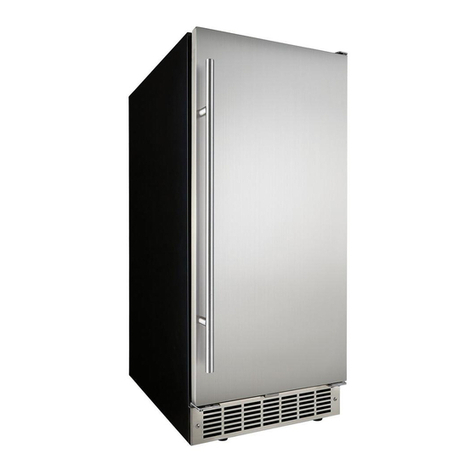
Silhouette
Silhouette DIM32D1BSSPR Owner's use and care guide
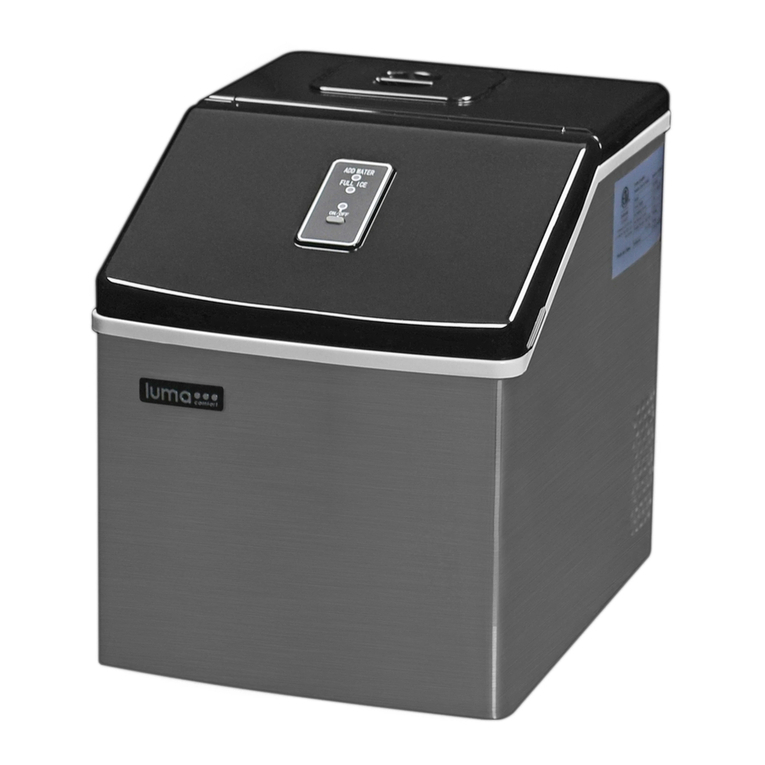
Luma
Luma Comfort IMPC-2800S owner's manual
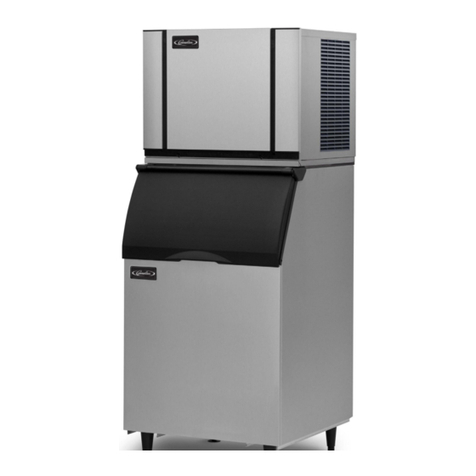
Cornelius
Cornelius NORDIC ELITE Series owner's manual
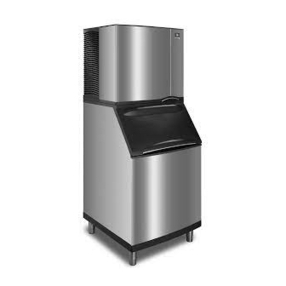
Manitowoc
Manitowoc S model Service manual

Summit
Summit BIM44GIF user manual
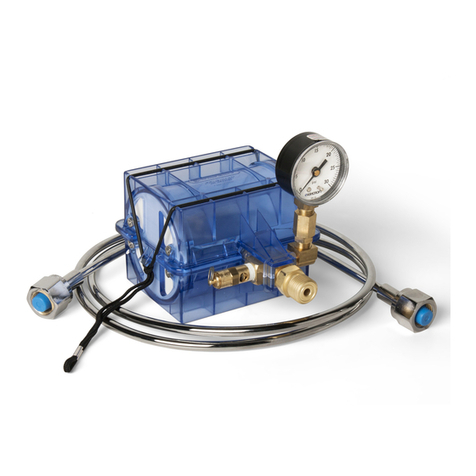
Electron Microscopy Sciences
Electron Microscopy Sciences Frigimat Cub Instructional manual
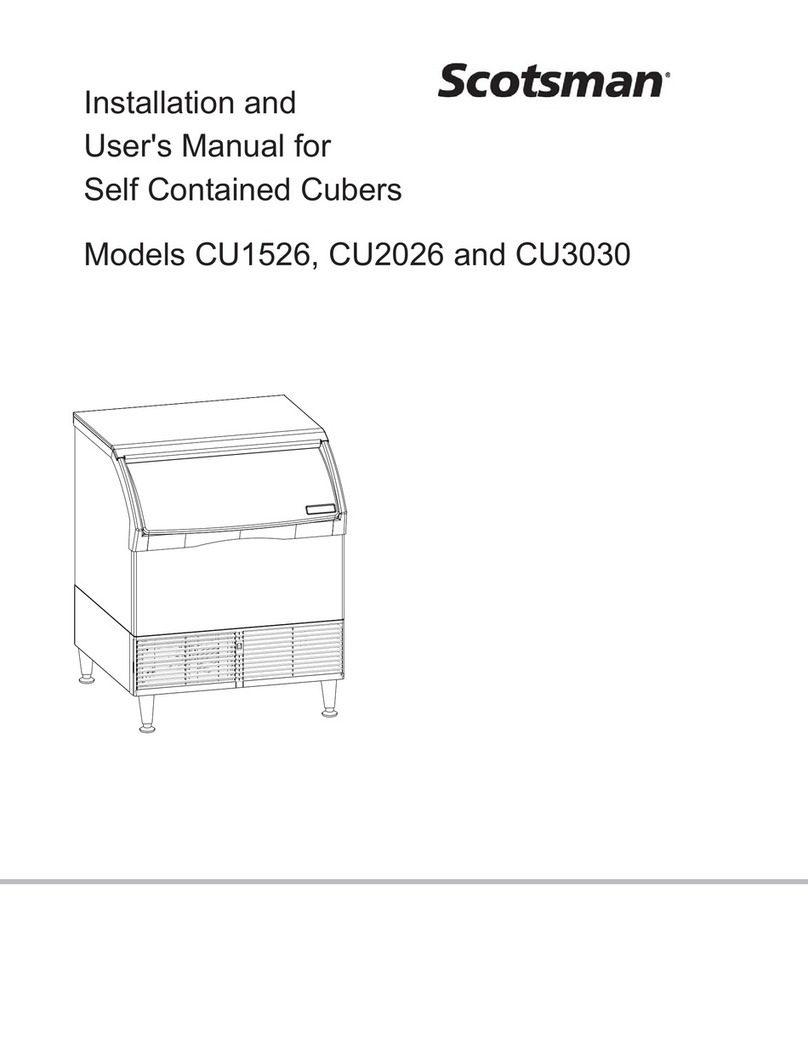
Scotsman
Scotsman Self Contained Cuber CU1526 user manual
